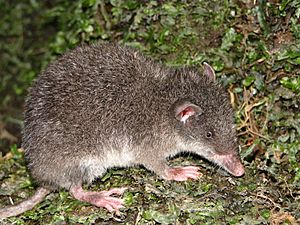Eastern caenolestid facts for kids
Quick facts for kids Eastern caenolestid |
|
|---|---|
 |
|
| Holotype, Sangay National Park, Ecuador | |
| Conservation status | |
| Scientific classification | |
| Genus: |
Caenolestes
|
| Species: |
sangay
|
The eastern caenolestid (Caenolestes sangay) is a small, mouse-like shrew opossum. It lives on the eastern slopes of the Andes mountains in southern Ecuador.
What's in a Name?
The name of the eastern caenolestid tells us a bit about it. The first part of its scientific name, Caenolestes, comes from ancient Greek words. Kainos means "new," and lestes means "robber" or "pirate."
The second part of its name, sangay, comes from Sangay National Park. This is a very large national park in the Andes mountains of Ecuador. The park itself is named after a volcano called Sangay. This volcano is one of the most active volcanoes in Ecuador. Scientists first discovered the eastern caenolestid in Sangay National Park in 2010.
Family Tree: Where it Belongs
The eastern caenolestid is one of five types of animals in the Caenolestes group. All these animals belong to a family called Caenolestidae, which are known as shrew opossums.
For a long time, scientists thought that Caenolestes animals were closely related to the Incan caenolestid (Lestoros). However, over the years, they noticed that the Incan caenolestid looked different from Caenolestes.
In 2013, a study looked closely at their body shapes and their mitochondrial DNA. This study showed that the Incan caenolestid and the long-nosed caenolestid are actually closer to each other. They form a special group that is a "sister" group to Caenolestes. This means they share a common ancestor.
Here is a simplified family tree showing how these animals are related:
|
|||||||||||||||||||||||||||||||||||||||||||||||||
Scientists have found fossils of shrew opossums that are very old. Some of these fossils date back to the early Eocene period, which was almost 55 million years ago.
See also
 In Spanish: Caenolestes sangay para niños
In Spanish: Caenolestes sangay para niños


